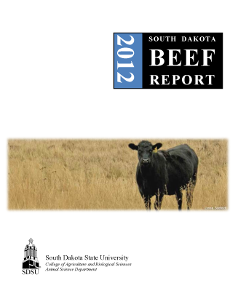Document Type
Report
Report Number
2012-3
Publication Date
2012
Summary
Our objective was to determine if early weaning (about 125 d) vs. normal weaning (about 250 d) and wintering replacement heifers in drylot vs. rangeland affected heifer growth and reproductive performance. Heifer calves from the 2009 and 2010 calf crops (n = 104 and 73, respectively) were allocated to the 2 weaning treatments and then stratified by age into the 2 winter development treatments forming a 2 by 2 factorial arrangement of treatments. Heifers wintered in drylot received mixed grass and alfalfa hay (yr 1: 11.6% CP, 52.5% TDN; yr2: 12.3% CP, 53.4% TDN) plus 1.8 kg of a dried distiller’s grain (DDGS)-based supplement/hd/d (yr1: 22.7% CP, 75.8% TDN; yr 2: 25.4% CP, 76.7% TDN). Heifers wintered on rangeland also received 1.8 kg/hd/d of the same supplement. Over the winter, each treatment was allocated to a separate pen or pasture. After estrus synchronization and timed AI, all heifers were placed on rangeland to graze through the summer. During the summer of yr 1, heifers were allocated by winter treatment to 2 pastures, and in yr 2 all 4 treatment combinations were allocated to separate pastures. Responses measured were BW, ADG, pubertal status at initiation of estrus synchronization, and pregnancy status after breeding. Pubertal status was indicated by serum progesterone > 1 ng/ml. A winter by weaning treatment interaction affected (P<0.001) BW and ADG both years. During the winter months, range heifers were lighter and grew slower than drylot heifers, but BW did not differ due to winter treatments at the end of the summer. However, early-weaned heifers remained lighter than normal weaned heifers at the end of the summer. Weaning treatment affected (P=0.03) fall pregnancy rate (93.2%±4.0 and 74.7%±7.98 for early- and normal-weaning, respectively) in yr 2. In yr 1, there was a difference (P=0.006) between drylot and range heifers (92.7%±3.52 and 72.8%±6.47, respectively) in the proportion that obtained puberty before estrus synchronization. In conclusion, producers should consider important interactions between weaning and winter management practices when establishing a replacement heifer development program that best fits the goals of their operation.
Number of Pages
6
Format
application/pdf
Language
en
Publisher
South Dakota State University
Rights
Copyright © 2012 South Dakota State University.
Recommended Citation
Hojer, N.L.; Hubert, M.B.; Johnson, P.S.; Price, M.H.; and Olson, K.C., "Effects of Weaning Age and Winter Development Environment on Heifer Performance" (2012). South Dakota Beef Report, 2012. 3.
https://openprairie.sdstate.edu/sd_beefreport_2012/3

